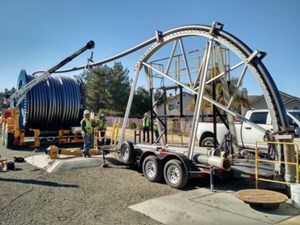PG&E moves power underground in plan to bury 10,000 miles
SANTA ROSA, Calif. (AP) — Pacific Gas & Electric Co. is working on an ambitious project to bury thousands of miles of power lines in an effort to prevent igniting fires with its equipment and avoid shutting down electricity during hot and windy weather.
PG&E announced last year that it planned to bury 10,000 miles (16,000 kilometers) of power lines in the next decade at a projected cost of $15 billion to $30 billion. The announcement came just days after PG&E informed regulators that a 70-foot (23-meter) pine tree that toppled on one of its power lines ignited a major fire in Butte County, the same rural area about 145 miles (233 kilometers) northeast of San Francisco where another fire sparked by its equipment killed more than 80 people and destroyed thousands of homes in 2018.
Since 2017, the aging equipment of the nation's largest utility has been blamed for more than 30 wildfires that wiped out more than 23,000 homes and businesses and killed more than 100 people. In 2019, PG&E filed for bankruptcy after facing billions of dollars in wildfire fines and lawsuits.
In addition to preventing wildfires, PG&E says burying power lines underground will lead to fewer disruptive public safety power shutoffs, which have become more frequent in the last few years due to dry weather and high wind events linked to climate change.
PG&E previously has buried power lines as systems are rebuilt in the wake of destructive wildfires, such as the massive blaze that wiped out most of the town of Paradise in 2018. This month, it started work on a plan to place 175 miles (280 kilometers) of power lines underground this year in central and Northern California, said Deanna Contreras, a PG&E spokeswoman.
The company has said it plans to bury as many as 1,200 miles a year to meet its goal.
“Undergrounding reduces ignition risk by 99% so we are starting in the areas of the highest fire risk, high fire threat district areas, and also prioritizing areas where we can reduce the number of public safety power shutoffs,” she said.
She said burying power lines costs $3.75 million per mile.
“As we increase the line miles every year and we scale up, we expect those costs to come down to about $2.5 million a mile by the end of 2026,” she added.
But some critics of PG&E’s plan say it’s too expensive and will take too long to complete. The plan calls for ratepayers to finance the project through higher utility bills.
The Utility Reform Network, or TURN, a consumer advocacy organization, questions whether PG&E will be able to continue properly maintaining its power lines while it focuses on the burying power lines, which will take at least a decade to complete.
“This would take years upon years and we need to be sure that the company is focusing on its compliance in the meantime,” said Katy Morsony, a TURN staff attorney. “By also trying to engage in this huge capital investment program at the same time, it’s unclear that they can both properly manage compliance in the meantime, as well as successfully and efficiently complete the undergrounding program.”
Related News
From Archive

- Glenfarne Alaska LNG targets late-2026 construction start for 807-mile pipeline project
- U.S. water reuse boom to fuel $47 billion in infrastructure spending through 2035
- $2.3 billion approved to construct 236-mile Texas-to-Gulf gas pipeline
- Major water pipe break in Puerto Rico hits over 165,000 customers
- Potomac River Tunnel project enters construction phase beneath Washington, D.C.
- Pennsylvania American Water launches interactive map to identify, replace lead water service lines
- Trump's tariffs drive $33 million cost increase for Cincinnati sewer project
- Utah city launches historic $70 million tunnel project using box jacking under active rail line
- Tulsa residents warned after sewer lines damaged by boring work
- Fatal trench collapse halts sewer construction in Massachusetts; two workers hospitalized




Comments